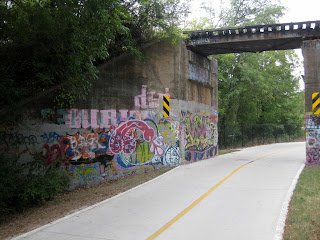Klyde Warren Park opened on October 27, 2012. It lies on the north side of Downtown Dallas in the city's Arts District. It's smack dab next to the Dallas Museum of Art, the Nasher Sculpture Garden, and the new (and infamous for its art-destroying glare) Museum Tower.
So, you may know the story already: they built an urban park on top of a recessed highway. Yep, the park just floats in the air while the cars whiz underneath. Some call it an engineering feat. Actually, thousands do. This park has proven within months of opening that it is the big daddy of Dallas parks. Well, in terms of popularity at least.
I didn't know what to think when I first heard about it. I thought it could turn out to be another tacky Dallas attraction with more glitz than substance. And, while it is packed with sleek amenities (Dallas can't do anything minimal), I have to say...it worked.
It worked! But just how did it work? Is it that people are really moving back Downtown? Does it do as it proposed and actually connect Downtown with Uptown? Well, I didn't realize how close (10 min walk) the beautiful State-Thomas neighborhood (a semi-hidden enclave in Uptown) was to the park until a couple weeks ago. My guess is that it's a mix of Downtown and Uptown residents, as well as those closer to the urban core (think: East Dallas, Oak Lawn).
However and from wherever the people come...they come. Trust me, I've been a regular fixture since its opening, having graced the park 6 or 7 times in the last few months. On a sunny day, Klyde Warren Park is filled with droves of people. They walk around. Their kids play on the impressive playground. Families or friends play frisbee and toss footballs on the Great Lawn. And it's not just rich Downtown/Uptown people--it's a healthy mix.
I get all sappy when I come here. It's a refreshing addition to our urban environment.
The Great Lawn is probably the biggest physical feature of the park. It's a big, open lawn that is approachable and often filled with families tossing footballs or frisbees.
The immense skyline lurks in the background. Quite pretty, to be honest.
Archways and Red Oaks frame a nice walkway which goes around the perimeter of much of the park.
Food trucks have become a permanent fixture on the South side of the Great Lawn.
By the Nasher Sculpture Garden, next to Klyde Warren Park
.jpg)
.jpg)
.jpg)

.jpg)



.jpg)
.jpg)
.jpg)
.jpg)
.jpg)
.jpg)
.jpg)
.jpg)
.jpg)
.jpg)
.jpg)
.jpg)
.jpg)
.jpg)
.jpg)
.jpg)
.jpg)
.jpg)
.jpg)
.jpg)
.jpg)
.jpg)
.jpg)





.jpg)
.jpg)



.jpg)




.jpg)
.jpg)

